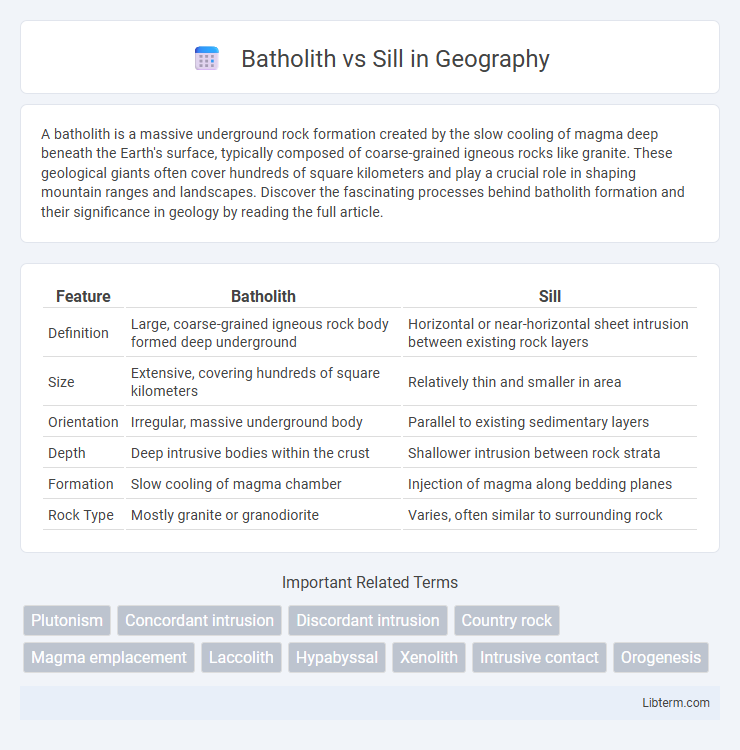A batholith is a massive underground rock formation created by the slow cooling of magma deep beneath the Earth's surface, typically composed of coarse-grained igneous rocks like granite. These geological giants often cover hundreds of square kilometers and play a crucial role in shaping mountain ranges and landscapes. Discover the fascinating processes behind batholith formation and their significance in geology by reading the full article.
Table of Comparison
| Feature | Batholith | Sill |
|---|---|---|
| Definition | Large, coarse-grained igneous rock body formed deep underground | Horizontal or near-horizontal sheet intrusion between existing rock layers |
| Size | Extensive, covering hundreds of square kilometers | Relatively thin and smaller in area |
| Orientation | Irregular, massive underground body | Parallel to existing sedimentary layers |
| Depth | Deep intrusive bodies within the crust | Shallower intrusion between rock strata |
| Formation | Slow cooling of magma chamber | Injection of magma along bedding planes |
| Rock Type | Mostly granite or granodiorite | Varies, often similar to surrounding rock |
Introduction to Batholiths and Sills
Batholiths are large, coarse-grained intrusive igneous rock bodies that form deep beneath the Earth's surface through the slow cooling of magma, typically covering areas greater than 100 square kilometers. Sills are tabular, sheet-like intrusions that intrude parallel to existing rock layers, solidifying between them and generally much thinner and more extensive laterally than batholiths. Both features represent different modes of magma emplacement, with batholiths contributing to the formation of mountain cores and sills influencing stratigraphy and local geology.
Definition of Batholith
A batholith is a massive, irregularly shaped intrusive igneous rock body that forms deep within the Earth's crust through the slow cooling of magma, often covering hundreds of square kilometers. It differs from a sill, which is a smaller, tabular intrusion that forms parallel to existing rock layers near the surface. Batholiths are typically composed of coarse-grained granite or granodiorite and serve as the foundational core of many mountain ranges.
Definition of Sill
A sill is a tabular sheet intrusion that forms when magma intrudes parallel to existing rock layers, solidifying between them. Unlike batholiths, which are large, coarse-grained plutonic bodies that form deep underground over millions of years, sills are typically thinner and concordant with surrounding strata. The formation of sills plays a crucial role in altering the thermal and structural characteristics of sedimentary basins.
Formation Processes: Batholith vs Sill
Batholiths form from large magma bodies that cool slowly deep within the Earth's crust, creating massive, coarse-grained igneous rock formations. Sills develop when magma intrudes horizontally between existing rock layers, solidifying as thin, tabular sheets parallel to sedimentary strata. The key difference lies in their emplacement depths and orientation, with batholiths forming deep and large plutons, while sills are shallow, concordant intrusions.
Geological Characteristics and Features
Batholiths are massive, irregularly shaped intrusive igneous bodies that form deep beneath the Earth's surface, typically covering hundreds of square kilometers and composed primarily of coarse-grained granite. Sills are tabular, concordant intrusive bodies that intrude parallel to existing sedimentary layers and are generally thinner and more extensive in lateral spread than dikes. Batholiths solidify slowly at great depths, resulting in coarse crystalline textures, while sills form at shallower depths, often displaying fine to medium-grained textures due to faster cooling.
Size and Scale Differences
Batholiths are massive, intrusive igneous rock bodies that span tens to hundreds of kilometers in surface exposure and extend deep into the Earth's crust, representing some of the largest plutonic formations. Sills are comparatively smaller, tabular intrusions that typically range from a few meters to several kilometers in length and thickness, emplaced parallel to existing sedimentary layers. The vast scale difference reflects batholiths' role in continental crust formation, while sills commonly serve as localized magma intrusions within sedimentary basins.
Rock Types and Mineral Composition
Batholiths primarily consist of coarse-grained intrusive igneous rocks such as granite, granodiorite, and diorite, characterized by abundant quartz, feldspar, and biotite minerals. Sills are typically composed of fine- to medium-grained mafic to intermediate rocks like basalt, diabase, or andesite, containing plagioclase feldspar, pyroxene, and sometimes olivine. The mineral composition of batholiths reflects slower cooling processes deep within the crust, resulting in large, well-formed crystals, while sills cool more rapidly near the surface, producing smaller mineral grains.
Examples of Famous Batholiths and Sills
The Sierra Nevada Batholith in California and the Coast Range Batholith in British Columbia are prominent examples of massive igneous intrusions formed deep within the Earth's crust. In contrast, the Palisades Sill along the Hudson River in New York and New Jersey and the Whin Sill in northern England represent well-known horizontal, sheet-like intrusions that solidified between existing rock layers. These geological formations provide critical insights into magmatic activity and tectonic processes shaping continental crust.
Importance in Geology and Earth Sciences
Batholiths represent massive, deep-seated intrusive igneous bodies that provide crucial insights into continental crust formation, magmatic processes, and tectonic history. Sills, as tabular intrusions parallel to sedimentary layers, help geologists understand magma intrusion mechanisms, sedimentary basin evolution, and thermal alteration of surrounding rocks. Both structures are fundamental in reconstructing geological timelines and mineral exploration strategies.
Key Differences: Batholith vs Sill
Batholiths are large, deep-seated igneous intrusions that form massive, irregularly shaped bodies of coarse-grained granite or similar rock, often covering hundreds of square kilometers. Sills are smaller, tabular intrusions that inject parallel to existing rock layers, typically composed of basalt or dolerite, and are much thinner and laterally extensive compared to batholiths. The key differences between batholiths and sills include size, depth of formation, and orientation relative to surrounding rock strata.
Batholith Infographic

 libterm.com
libterm.com